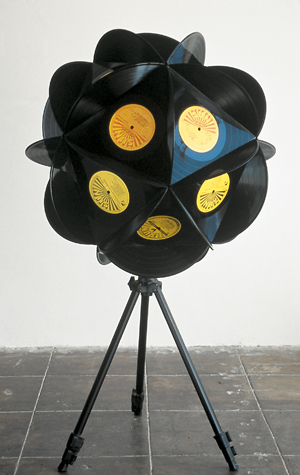LPs as You’ve Never Seen (or Heard) Them
ICA show celebrates vinyl records

In what may be the most whimsical art exhibition in Boston this year, the Institute of Contemporary Art’s The Record: Contemporary Art and Vinyl pays homage to albums in sometimes dizzying ways. The show is being billed as the first museum exhibition to draw connections between contemporary art and vinyl records.
Featuring nearly 100 works by 41 people, ranging from legendary performance artist Laurie Anderson to painter Jasper Johns to Talking Heads front man David Byrne, the ICA exhibition spans six continents and embodies the impact albums have made on global culture.
“The exhibit is like a record store,” says Trevor Schoonmaker, Patsy R. and Raymond D. Nasher Curator of Contemporary Art at the Nasher Museum of Art at Duke University, where the show was first mounted. “There are the hits that draw you in right away, and then when thumbing through the records you come across something you’ve never heard of—that is perhaps more inspiring.”
Entering the exhibition, visitors are met by William Cordova’s towering piece Greatest Hits (2008), a stack of records reaching more than 10 feet. Satch Hoyt’s Celestial Vessel (2009) is a canoe made entirely out of records. Suspended above the heads of viewers, it loops audio recordings from artists ranging from Tchaikovsky to James Brown and Kelis.
Another gallery features the work of two very different artists. In the center of the room is a collection of album covers from the civil rights and Vietnam War era. The covers depict fictional soul superstar Mingering Mike, the alter ego of an unidentified African American teenager who designed the covers, but never recorded any music.
Nearby is the work of Talking Heads Grammy-winning musician Byrne. Hanging on one wall is an eight-foot version of the album cover he designed for the group’s 1985 record More Songs about Buildings and Food, created using Polaroid photos.
An interactive exhibit waits in the back gallery, where a wall is adorned with two large prints of the Sun Studio, home of the King himself, Elvis Presley. Named after a Presley song, Mark Soo’s installation That’s That’s Alright Alright Mama Mama (2006) invites viewers to put on 3-D glasses, making them feel as if they’re actually standing in the recording studio.
Jeroen Diepenmaat, Pour des dents d’un blanc éclatant et saines, 2005. Record players, vinyl records, taxidermied birds, and sound. Dimensions variable. Image courtesy of Jeroen Diepenmaat
Jeroen Diepenmaat’s humorous Pour des dents d’un blanc éclatant et saines (2005) is one of the more arresting visual images in the show, a work that combines vinyl records and taxidermy. In this piece, Diepenmaat substitutes a bird’s beak for a record player’s needle—the records being played are, in fact, bird calls.
Laurie Anderson’s Viophonograph (1997) blurs the lines between live performance, audio recordings, and instruments. To create the piece, Anderson took the strings off a violin and replaced them with a battery-operated turntable, which plays a recording of notes plucked on a violin.
For those who don’t recall what it was like to listen to LPs, be sure to check out the record-listening stations, where you can rock out to the Beatles’ Sgt. Pepper’s Lonely Hearts Club Band or Black Sabbath’s Paranoid.
The ICA hosts $15 student DJ night on Fridays throughout August.
Admission to the Institute of Contemporary Art, 100 Northern Ave., Boston, is free for BU students with a valid ID, $15 general admission. Take the MBTA’s Red Line to South Station and from there the Silver Line bus to the Court House stop. The Record: Contemporary Art and Vinyl runs through September 5. More information is available here or by calling 617-478-3100.
John Fichera can be reached at jfichera@bu.edu.

Comments & Discussion
Boston University moderates comments to facilitate an informed, substantive, civil conversation. Abusive, profane, self-promotional, misleading, incoherent or off-topic comments will be rejected. Moderators are staffed during regular business hours (EST) and can only accept comments written in English. Statistics or facts must include a citation or a link to the citation.